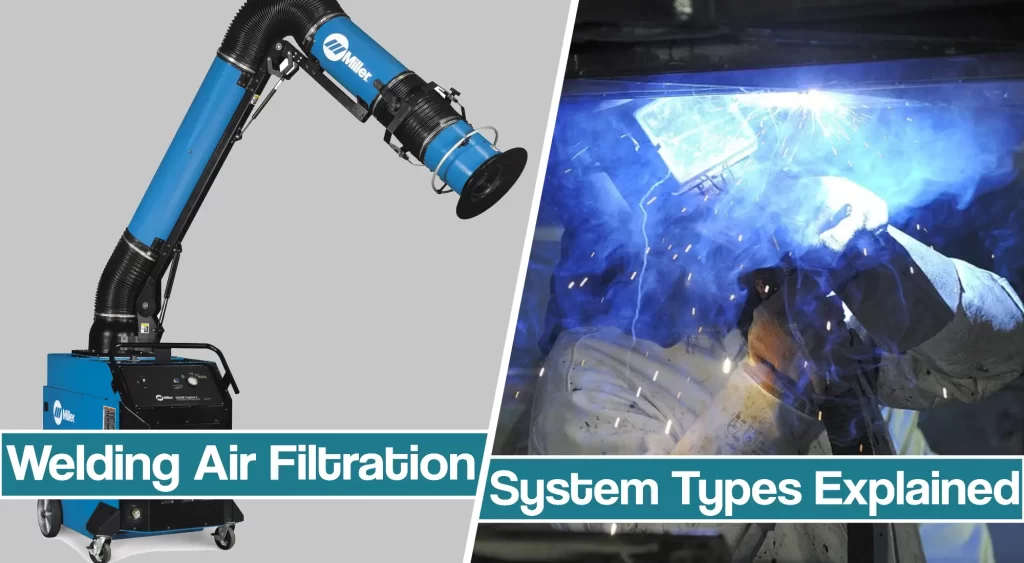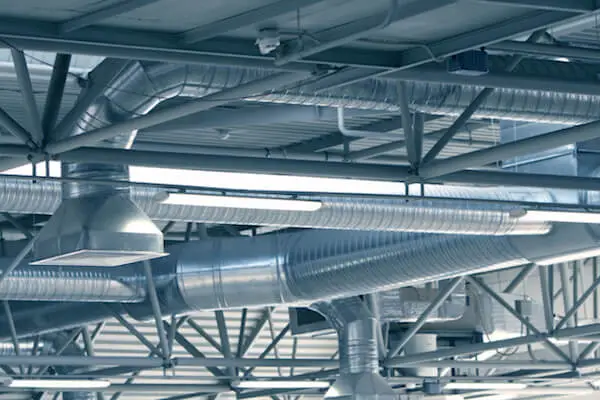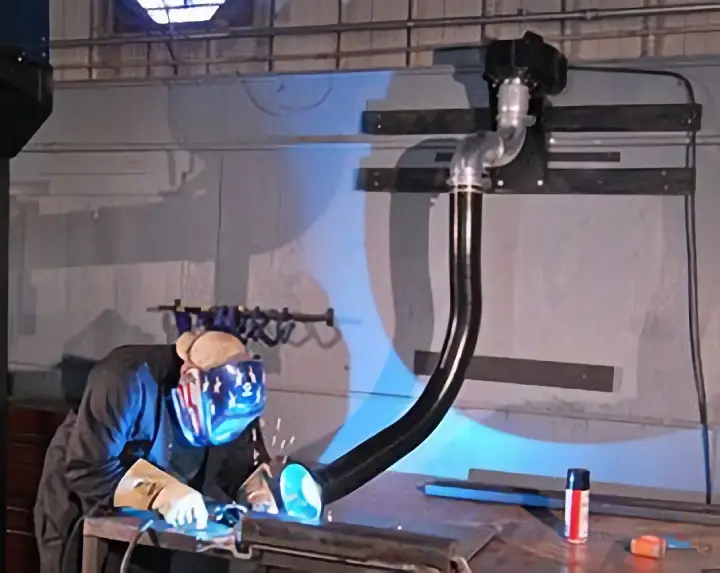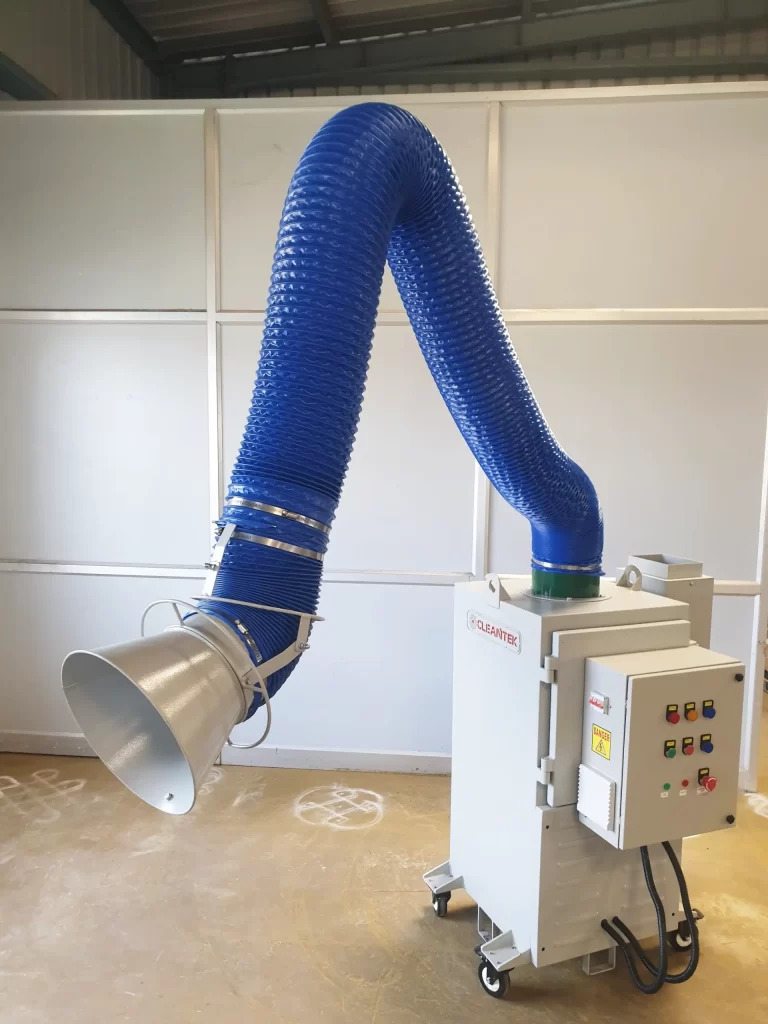Welding shops, industrial welding facilities, and even your welding garage set up need some kind of air filtration and ventilation.
Welding fumes are cancerogenic, but they also cause numerous serious health issues. So, to prevent the worst, welding air filtration systems are created and usually mandated by welding codes and standards.

In this article, you’ll learn about different types of air filtration available for welding shops and industrial complexes.
Air Filtration System Types
Four primary methods of air filtration in use today are general ventilation (ambient air treatment or exhaust), ambient filtration, source capture exhaust, and source capture filtration.
Each method has particular uses, benefits, and drawbacks.
General Ventilation (Exhaust)
These systems use large fans to draw contaminated air from the plant and exhaust it directly outside into the environment, typically through the roof or walls.
Such a system generally is used in geographical areas where the climate is temperate, heating and cooling costs are a minimal concern, and contaminants in the plant’s air do not violate EPA air quality standards and can safely be emitted into the environment.
However, this method sucks climate controlled air out of the plant, which in colder climates amounts to significantly increased energy costs to keep the plant comfortable for employees.

Additionally, without area-specific ductwork, eddy currents of slow-moving air form in corners of the plant, due to structural obstacles restricting airflow and weak air currents generated by poorly placed or undersized fans. In such areas, the chance of employee exposure to weld fumes or other inplant-formed atmospheres increases.
Ambient Air Filtration
The ambient air filtration method is very similar to the general ventilation system, with one notable difference.
Contaminated air from the plant is collected in the same manner but is forced through a filtration media and returned to the plant. This eliminates much of the increased energy costs for climate control because climate-controlled air is kept inside the building; however, maintenance and cleaning costs increase as the filter media needs to be frequently replaced and the area around the intake must be cleaned often of dust deposits that build up rapidly.
Moreover, the method still does not address the possibility of workspace-localized weld fume exposure.
Welding Fumes Air Systems That Capture Fumes at The Source
An improvement that better addresses weld fumes is the source capture system, which uses either specially-designed intake hoods or a containment structure such as a hood or walled area in the welding area.
Hoods used in such a system range from large hoods that are mounted above and cover the entire welding area to small hoods that are installed inches from the welding activity.
The captured contaminated air is drawn through a duct system and exhausted outside the plant into the environment. As with a general ventilation system, the plant’s climate-controlled air is exhausted out, also affecting energy costs in colder regions.

Additionally, this method is subject to EPA regulations regarding the contaminants exhausted into the environment. Moreover, the ductwork involved in such a system generally is permanent, making production line changes in the plant difficult and more costly.
Finally, hoods and ductwork close to the welding activity must be resistant to the risk of fire posed by sparks sucked into the system.
The most effective method is source capture with filtration, with filtration equipment incorporated into the process to clean the captured air, which then is returned to the plant.
With this system, there is little or no impact on energy costs as climate controlled air stays inside the plant. The filtration units can be mounted near or above the welding activity, eliminating the need for extensive ductwork.
The initial investment for this equipment is higher than other systems, but operational costs are low. Most importantly, industrial HVAC specialists and purveyors of fume filtration systems say that cleaning a shop’s breathing air can lead to a reduction in health risks to employees, which in turn translates to less absenteeism and improved individual performance.
Another way of filtering the air at the source is to use PAPR welding helmets. Such systems allow operators to breathe mechanically moved and filtered air regardless of the distance between them and the shop’s air filtration system.
Welding Air Filtration System Selection
A proper fume ventilation program does not need to wait for a company to move to new quarters, or even cause lengthy shutdowns of a production line.
Moreover, new technologies in blower motor design, such as variable-frequency drive control, incur lower energy costs than units of a decade ago.
Modular fume treatment systems are available to fit nearly anywhere in a plant.
For confined spaces, several manufacturers, including Great Lakes Air Systems, Lincoln Electric, and Torit, offer cabinet-sized units that can be rolled next to a work area and operate off of a standard 120V power outlet.
A flexible duct extends from the body of the unit, allowing exact placement of the fume intake close to a weld operation.

Fire suppression is a crucial factor when choosing any fume venting equipment that is to be used around a welding process. Users have to ensure that the extraction opening is not close to the actual welding point so that sparks have a chance of extinguishing before entry and that intake hoods and ducting can withstand a barrage of hot metal sparks.
Additionally, collection units currently on the market include internal systems that incorporate spark arrestors, baffles, changes in air velocity, or other mechanical means to extinguish sparks and prevent accumulated dust from igniting.
Filtration varies from manufacturer to manufacturer, both in filter media and the method incoming air is passed through the filter. Selection will depend on the amount of use the system is expected to receive, ease of maintenance of the filter and, if there are space constraints, how the filter affects the size of the collection unit.
Many units offer automatic filter cleaning systems that extend the life of the filter while reducing the frequency of unit maintenance. Fume removal systems are available and designed specifically for robotic welding stations.
Such equipment may include a surrounding curtain to enhance the efficiency of the fume collection within the weld cell, while control of the exhaust motor can be delegated to the robot’s computer so that activation and shut-off are tied to the weld cycle.
Alternatively, several robot cells can be ducted to a single collector appropriately designed for the intended volume of air.
Work with an HVAC Specialist
When considering fume control for a shop, a plant air specialist will help determine air volumes, unique work area requirements, and any other factors that will affect system selection.
It can be a serious mistake to treat plant air filtration systems as an afterthought. When you take that approach, you leave gaps. Or, maybe you use multiple contractors, and everything doesn’t come together as you had planned, so they end up blaming one another about whose fault it is while you tear your hair out. The real shame is that a specialist can put it all together for you in a turnkey package.
Conclusion
Generally, employee morale improves after the company installs an improved fume control system. Accordingly, production quality and output are improved, a benefit achieved without blowing any smoke.
It doesn’t matter if you run a small shop or a big production line; an air filtering system is necessary to prevent health issues and improve productivity. A small shop doesn’t have to invest much. Welding fume solutions are generally inexpensive nowadays.
But, if you run a bigger welding operation with multiple operators and your company welds coated metals like galvanized steel, you must provide a well-designed system to protect the health of your welding operators.




